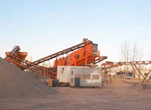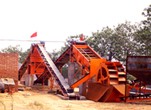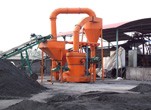The front end of slag dryer cylinder usually stretches into the deep of combustion chamber and often contacts with the high temperature flame. Under the effect of high temperature, cylinder material strength will decrease, so the port is easy to deform and crack. To solve this problem, our company is engaged in improving the structure of the front-end cylinder.
1. Firstly, process the front end of the cylinder for replacing, and this section of cylinder should be 1300 mm long. At the end part, there is welded an external flange ring additionally and added with 20 pieces of support plates. In this way, the intensity of the end port is reinforced. At the other end of the cylinder, process the welding groove properly. In order to prevent the cylinder from deforming, add a M support to the end where is no flange ring.

2. When the slag dryer is closed down, dismantle the positive frame and convex seal, and at the 1300 mm point from the front end, set up a scriber and then spin the dryer cylinder for a full circle. Then the scriber will leave a circle of clear scratches over the cylinder, which is the gas cutting line. In addition, at the 1500 mm point from the original cylinder, set up a M support to prevent the new port deforming after the front-end cylinder is cut off.
3. Cut the cylinder along the scribing line and remove the deformed front end. Open a welding groove on the port of the remaining cylinder and clean up the burrs on the port.
4. Lift the prepared cylinder beforehand and joint with the remaining cylinder, port to port. Control the radial and axial tolerance of the front end, and wield within the prescribed scope of the original equipment. Choose high manganese steel welding electrode to wield, which has similar performance with the cylinder material, by welding the inside and outside weld seams alternately. The thickness of each layer of welding seam should be not more than 5 mm.
The implementation of the above welding process effectively prevents cylinder's welding deformation.


